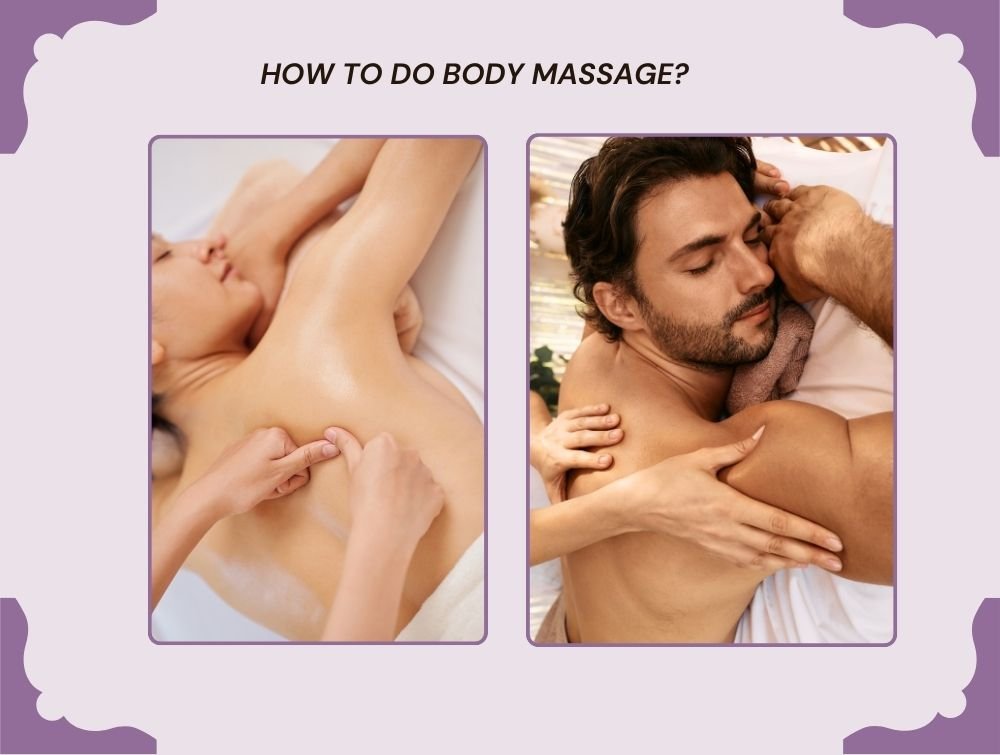A body massage is more than just a relaxing experience—it’s a therapeutic practice that supports both physical and mental well-being. From relieving muscle tension to promoting overall stress relief, a well-performed massage can make a significant difference in how the body feels and functions.
So, what makes a great body massage? It’s the perfect balance of technique, pressure, and intention. The process involves using hands, fingers, and sometimes even forearms or elbows to work on specific muscle groups, helping to ease tension, improve circulation, and foster deep relaxation.
For many, it’s also a valuable part of their self-care routine, promoting not only physical recovery but emotional wellness too.
One of the main reasons body massage remains so popular today is its effectiveness in stress relief and muscle recovery. Whether you’re dealing with the stiffness from long working hours or muscle fatigue from intense workouts, a tailored massage can help release tension and restore flexibility. Regular sessions can also contribute to better sleep, improved posture, and reduced anxiety.
At Fem Spa, we understand the importance of a well-executed massage. Our experienced professionals are dedicated to providing personalized massage services that focus on your unique needs whether you’re seeking relaxation, recovery, or a combination of both.
With a range of options, from soothing aromatherapy massages to focused deep tissue techniques, Fem Spa offers a space where wellness and tranquility meet.
What is Body Massage?
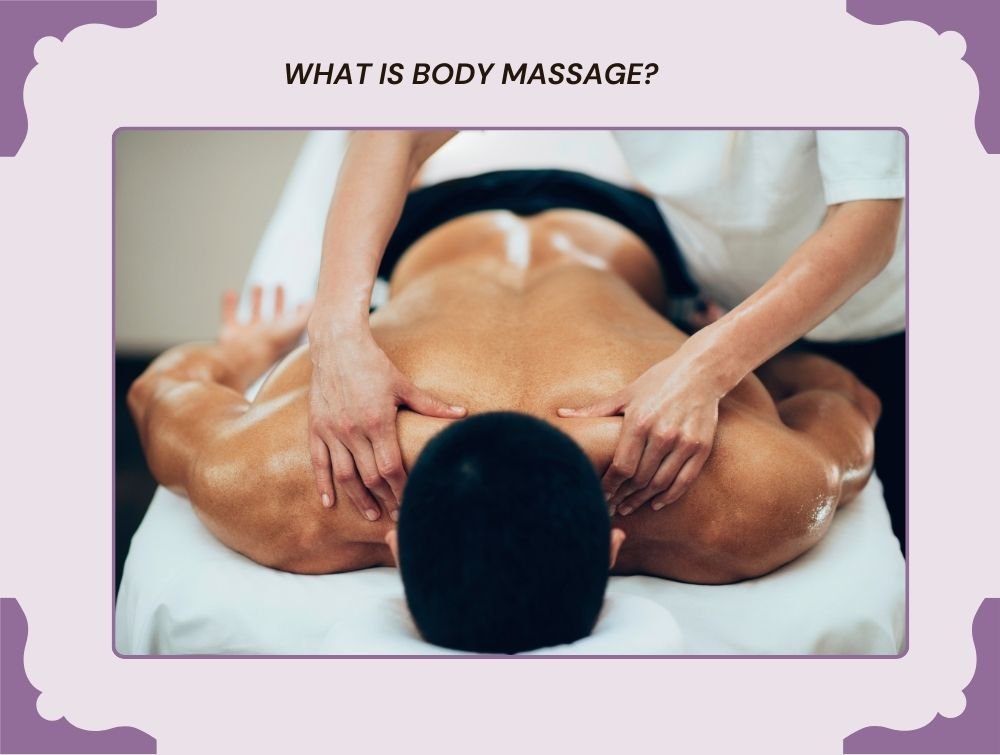
What is body massage? At its core, a body massage is a hands-on therapy focused on manipulating the muscles and soft tissues of the body to promote relaxation, ease pain, and support overall wellness.
Through a combination of pressure, movement, and specific techniques, body massages help release muscle tension, improve blood flow, and stimulate the body’s natural healing processes.
The practice of body massage has deep roots in various cultures, each contributing unique techniques and philosophies. In ancient India, Ayurvedic massage was developed as part of holistic healing, using herbal oils and rhythmic strokes to balance the mind and body. Traditional Chinese medicine emphasized acupressure and energy flow, aiming to maintain harmony within the body.
In Sweden, the creation of Swedish massage introduced structured techniques like kneading and long, gliding strokes that focused on muscle relaxation and improved circulation. Meanwhile, Thai massage incorporated elements of yoga and acupressure, using assisted stretching to enhance flexibility and energy flow.
Today, body massages are recognized not just for their physical benefits but also for their positive impact on mental health. Regular massages can reduce stress, alleviate chronic pain, and promote better sleep.
By targeting areas of tension and promoting relaxation, massages help balance both body and mind, making them an essential part of many people’s self-care routines.
Whether you’re seeking relief from muscle tightness or simply looking to unwind, a body massage offers a natural and effective way to support your overall well-being.
Benefits of Body Massage
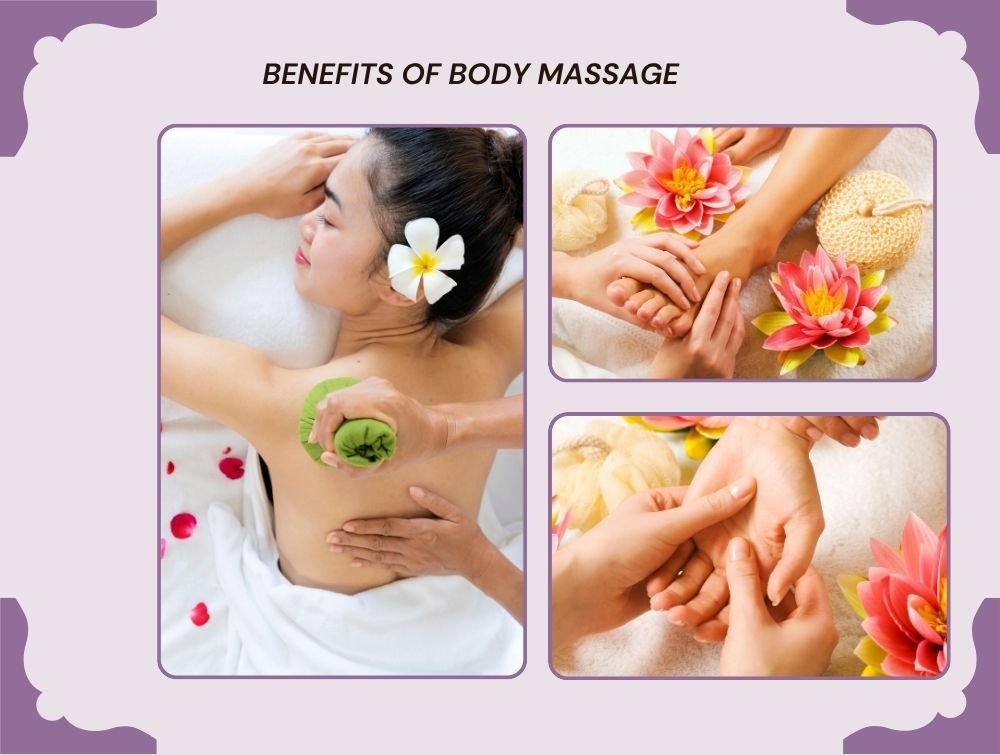
The benefits of body massage go far beyond simple relaxation. While many people turn to massage therapy as a way to unwind, it also offers a range of physical, mental, and therapeutic advantages that contribute to overall well-being. From improving circulation to reducing stress, here are some of the most impactful ways a body massage can help:
1. Relieves Muscle Tension and Pain
One of the primary reasons people seek massages is to relieve muscle tension and pain. By applying targeted pressure to specific muscle groups, massages help break down knots and release built-up tension. This can be especially beneficial for individuals dealing with chronic pain, sports injuries, or muscle stiffness from daily activities.
2. Improves Blood Circulation
A well-executed massage promotes better blood circulation, ensuring that oxygen and nutrients are efficiently delivered to muscles and tissues. Improved circulation supports faster muscle recovery, reduces fatigue, and helps the body eliminate toxins more effectively.
3. Reduces Stress and Anxiety
Massage therapy has a significant impact on mental health. According to the American Massage Therapy Association, 72% of people reported that massage therapy reduced their stress levels. The calming environment, combined with soothing massage techniques, helps lower cortisol (the stress hormone) levels and encourages the release of endorphins, improving overall mood.
4. Enhances Flexibility and Range of Motion
Regular massages can help loosen tight muscles and improve joint flexibility, making everyday movements smoother and more comfortable. This benefit is particularly valuable for athletes or individuals recovering from injuries, as it aids in restoring natural movement patterns.
5. Promotes Better Sleep
Many people who struggle with sleep find that regular massages help them relax and fall asleep more easily. By reducing stress and muscle tension, massages encourage a deeper, more restorative sleep, which in turn supports better overall health.
6. Supports Injury and Post-Surgery Recovery
Massages play an essential role in medical recovery. They help reduce swelling, improve circulation, and prevent scar tissue build-up, which can speed up the healing process after injuries or surgeries. Targeted massage techniques also help restore strength and mobility during rehabilitation.
7. Boosts Immune System Function
Some studies suggest that regular massage therapy can enhance the body’s natural immune response. By improving circulation and reducing stress levels, massages help the body function more efficiently, making it easier to fight off common illnesses.
Whether you’re seeking relief from chronic pain, looking to improve your flexibility, or simply aiming to reduce stress, the benefits of body massage are wide-ranging and impactful. Incorporating regular massages into your self-care routine can support both physical health and emotional well-being.
Types of Body Massage
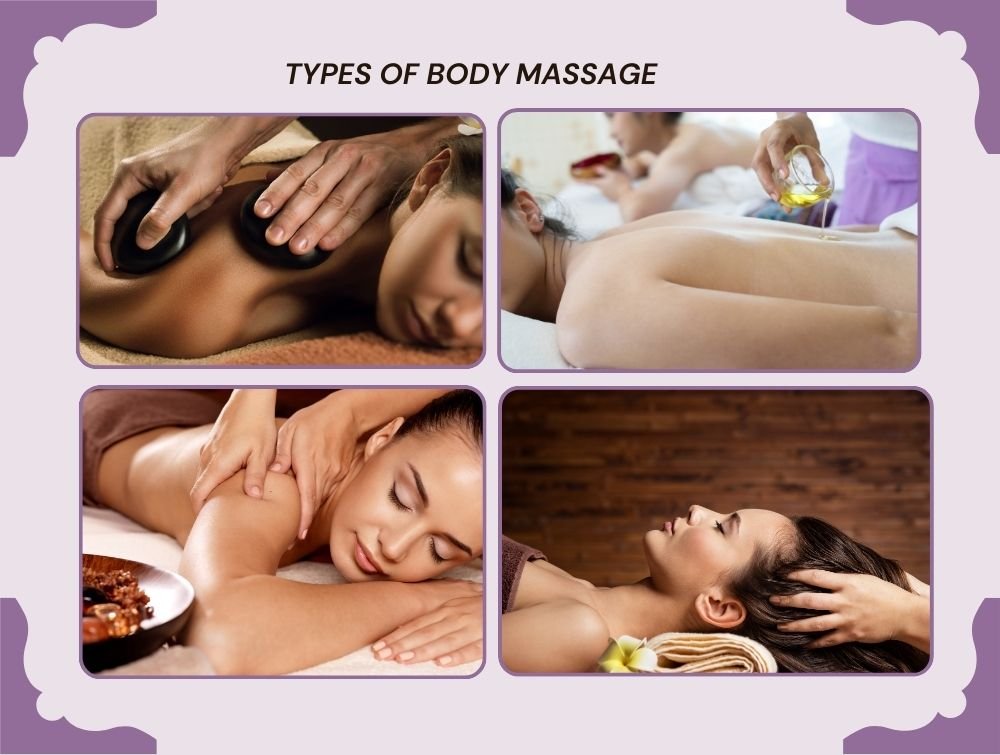
There are several types of body massage, each designed to cater to specific needs, whether you’re seeking relaxation, pain relief, or improved flexibility. Understanding the different body massage techniques can help you choose the one that best fits your goals. Here are some of the most popular options:
1. Swedish Massage
The Swedish massage is one of the most common and well-loved forms of body massage, perfect for those seeking deep relaxation. It uses long, gliding strokes, kneading, and gentle circular motions to ease muscle tension and improve circulation.
This technique helps reduce stress, promote relaxation, and is ideal for anyone new to massages or simply looking to unwind.
2. Deep Tissue Massage
For individuals dealing with chronic muscle tension or soreness, the deep tissue massage focuses on deeper layers of muscles and connective tissue. This technique uses slower, more forceful strokes to target knots and tight areas, helping to relieve pain and improve mobility.
At Fem Spa, we also offer deep tissue massage at home, providing a convenient option for those who prefer professional care in the comfort of their space.
3. Thai Massage
Originating from Thailand, Thai massage combines stretching and acupressure to improve flexibility, circulation, and energy flow. During the session, the practitioner uses their hands, elbows, knees, and even feet to apply pressure and guide you through assisted stretches.
This method is often described as a blend of yoga and massage, making it excellent for boosting flexibility and relieving joint stiffness.
4. Aromatherapy Massage
An aromatherapy massage enhances the traditional massage experience by incorporating essential oils. These oils, chosen for their specific properties, are either inhaled or absorbed through the skin during the massage.
Commonly used oils include lavender for relaxation, eucalyptus for decongestion, and peppermint for an energy boost. This type of massage not only soothes the muscles but also supports emotional well-being.
5. Hot Stone Massage
In a hot stone massage, smooth, heated stones are placed on specific points of the body and used to perform massage strokes. The warmth from the stones helps to loosen tight muscles, improve blood flow, and promote deep relaxation.
This technique is especially beneficial for individuals with muscle tension who prefer a gentler approach without the intense pressure of deep tissue massage.
These types of body massage offer a range of benefits, catering to different needs and preferences. Whether you’re looking for deep muscle relief with a deep tissue massage at home or want to relax with an aromatherapy massage, there’s a technique suited for everyone. Understanding these options makes it easier to choose the perfect massage for your unique needs.
How to Do Body Massage at Home (Step-by-Step Guide)
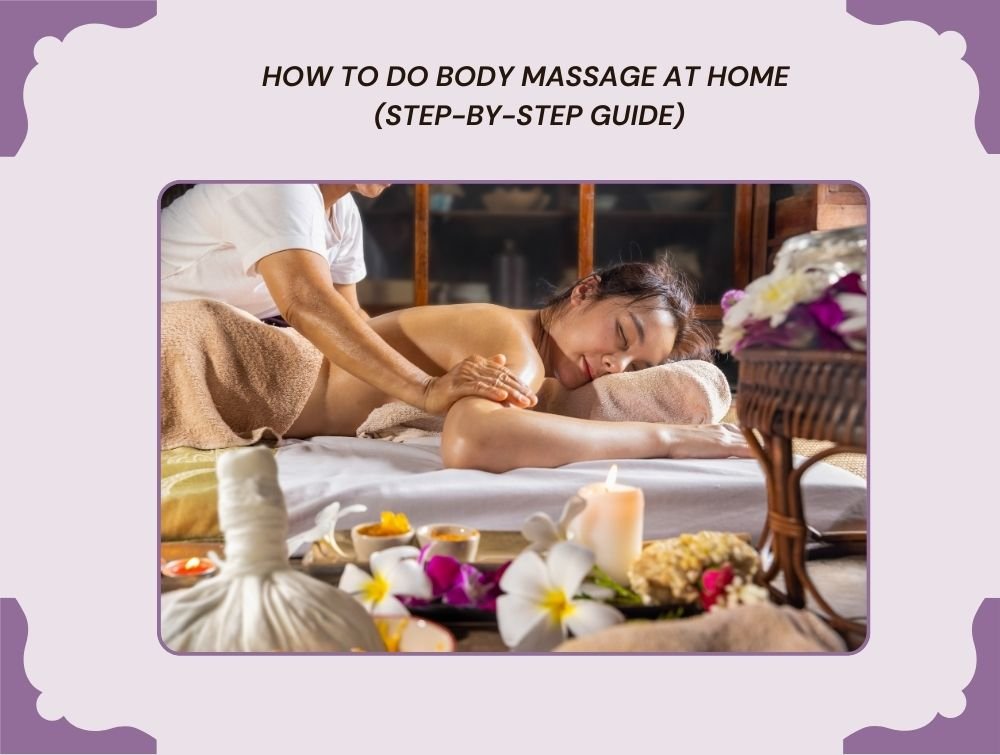
Learning how to do body massage at home can be a relaxing and therapeutic experience. With the right preparation and techniques, you can enjoy the benefits of a professional massage without leaving your space.
This step-by-step body massage guide at home will walk you through setting the perfect atmosphere, selecting the right oils, and mastering simple techniques to help release tension and promote relaxation.
Preparation for a Relaxing Body Massage
Before diving into massage techniques, it’s essential to create a calming environment. A peaceful setting will enhance the experience, making it more effective and enjoyable.
1. Set the Mood
- Lighting: Use soft, warm lighting to create a relaxing atmosphere. Dim the lights or use candles for a soothing glow.
- Calming Music: Gentle background music can help the mind relax. Choose nature sounds or instrumental tracks with a slow rhythm.
- Aromatherapy: Scents play a big role in setting the mood. Consider using a diffuser with essential oils like lavender or eucalyptus to promote relaxation.
2. Choosing the Right Oils
The best oils for body massage not only help your hands glide smoothly over the skin but also offer therapeutic benefits.
- Sweet Almond Oil: A popular choice for its smooth texture and mild scent.
- Coconut Oil: Great for deep hydration and a light, tropical fragrance.
- Jojoba Oil: Closely mimics the skin’s natural oils and is perfect for sensitive skin.
- Essential Oils: You can add a few drops of essential oils like lavender for relaxation or peppermint for an energizing effect.
Step-by-Step Instructions for a Home Massage
1. Start with Gentle Strokes
Begin with light, long strokes across the back or arms. This helps spread the oil evenly and warms up the muscles, preparing them for deeper work.
2. Apply Gradual Pressure
Increase pressure gradually, paying attention to how the muscles respond. Use your palms and fingers to press firmly but comfortably into the muscles. Always check in with the person receiving the massage to ensure the pressure feels right.
3. Use Classic Techniques
- Effleurage: Smooth, gliding strokes that warm up the muscles and promote relaxation.
- Kneading: Circular motions using the palms or knuckles to work deeper into the muscles.
- Tapping (Tapotement): Light, rhythmic tapping with the sides of your hands or cupped palms to stimulate the muscles and improve circulation.
4. Focus on Tension Areas
Spend extra time on areas that commonly hold tension, such as:
- Shoulders and Neck: Use kneading and circular motions to release tightness.
- Lower Back: Apply firm pressure with your palms, moving in slow, circular motions.
- Legs and Calves: Use long strokes followed by kneading to help relax these larger muscle groups.
Tips for Self-Massage at Home
If you’re performing a massage on yourself, certain techniques and tools can make it easier and more effective.
1. Massaging Hard-to-Reach Areas
- Back and Shoulders: Use a wall to roll a tennis ball between your back and the wall, applying pressure to tight spots.
- Neck: Use your fingers to gently knead the muscles at the base of your skull and along your shoulders.
2. Recommended Tools
- Foam Rollers: Ideal for large muscle groups like the back, thighs, and calves, helping release muscle knots and improve flexibility.
- Massage Balls: Great for pinpointing tight spots and applying targeted pressure.
- Handheld Massagers: These tools offer adjustable pressure and can be used on various parts of the body for deeper relief.
With this step-by-step body massage guide at home, you can create a calming space and use simple techniques to relax and rejuvenate. Whether you’re massaging a loved one or practicing self-massage, these methods can help reduce stress, ease muscle tension, and improve overall well-being.
Best Body Massage Techniques
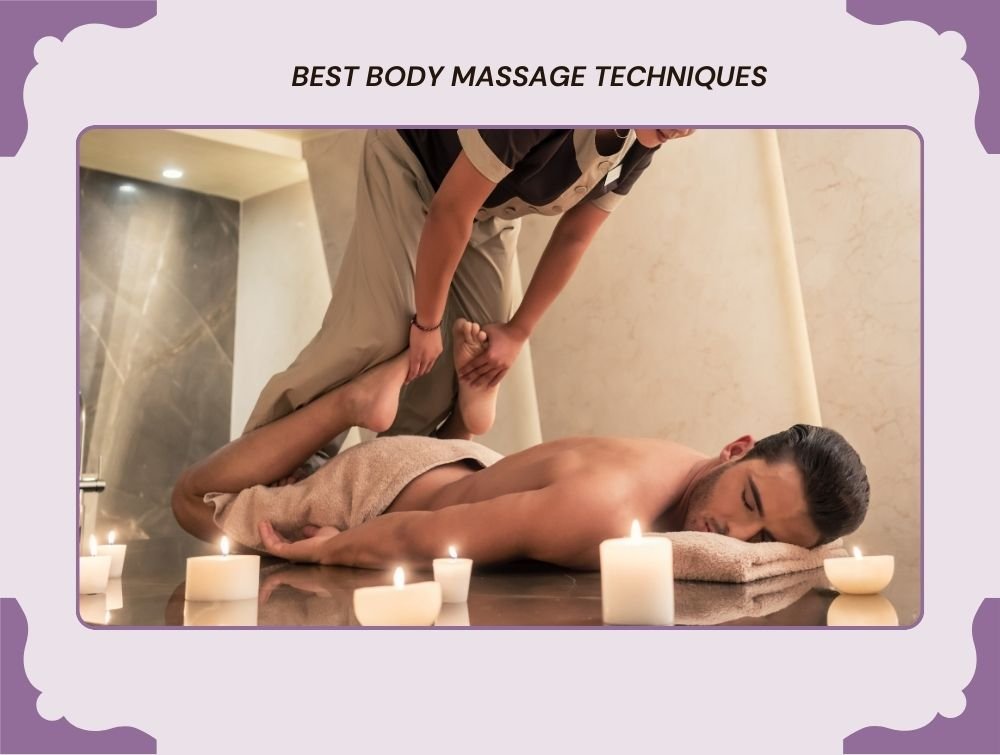
When it comes to relaxation and muscle relief, knowing which are the best body massage techniques can make all the difference. Each technique serves a specific purpose, whether it’s warming up the muscles, releasing tension, or promoting overall well-being.
Here are some of the most effective massage techniques for stress relief and muscle relaxation that you can use at home or during a professional session.
1. Effleurage – Gentle Strokes for Relaxation
Effleurage is often the starting point of most massages. It involves smooth, gliding strokes using the palms or fingertips. These light motions help warm up the muscles, spread massage oil evenly, and promote relaxation. Effleurage also stimulates blood flow and prepares the body for deeper massage techniques.
Best for: Starting and ending a massage, promoting relaxation, and improving circulation.
2. Petrissage – Deep Kneading to Release Tension
Petrissage is a kneading motion that works deeper into the muscles. The technique involves lifting, rolling, and squeezing the soft tissues, helping to break down knots and improve flexibility. It’s particularly effective in areas that tend to hold tension, such as the shoulders, neck, and thighs.
Best for: Relieving muscle tension, improving flexibility, and enhancing circulation.
3. Tapotement – Rhythmic Tapping for Stimulation
Tapotement consists of quick, rhythmic tapping or percussive movements. Using the sides of the hands, cupped palms, or fingertips, the massage therapist applies light, rapid strikes to the muscle. This technique stimulates circulation, improves muscle tone, and energizes the body.
Best for: Energizing the muscles, improving circulation, and stimulating the nervous system.
4. Friction – Deep, Circular Motions for Muscle Knots
Friction involves applying firm, circular movements using the fingers or thumbs. This technique targets deeper layers of muscles and connective tissue to break down adhesions and improve flexibility. It’s especially useful for addressing muscle knots and areas of chronic tension.
Best for: Releasing muscle knots, improving mobility, and addressing deep tissue issues.
5. Vibration – Gentle Shaking for Muscle Relaxation
Vibration uses rapid shaking or trembling movements to loosen muscles and reduce tension. The therapist applies gentle, oscillating motions to specific muscle groups, helping to relax the body and stimulate blood flow. Vibration can be especially soothing for sensitive or sore areas.
Best for: Relaxing muscles, reducing tension, and calming the nervous system.
By understanding which are the best body massage techniques, you can tailor each massage session to your specific needs, whether you’re focusing on stress relief, muscle recovery, or relaxation. Incorporating these effective massage techniques for stress relief into your routine can improve circulation, ease tension, and promote a greater sense of well-being.
Who Should Get a Body Massage?
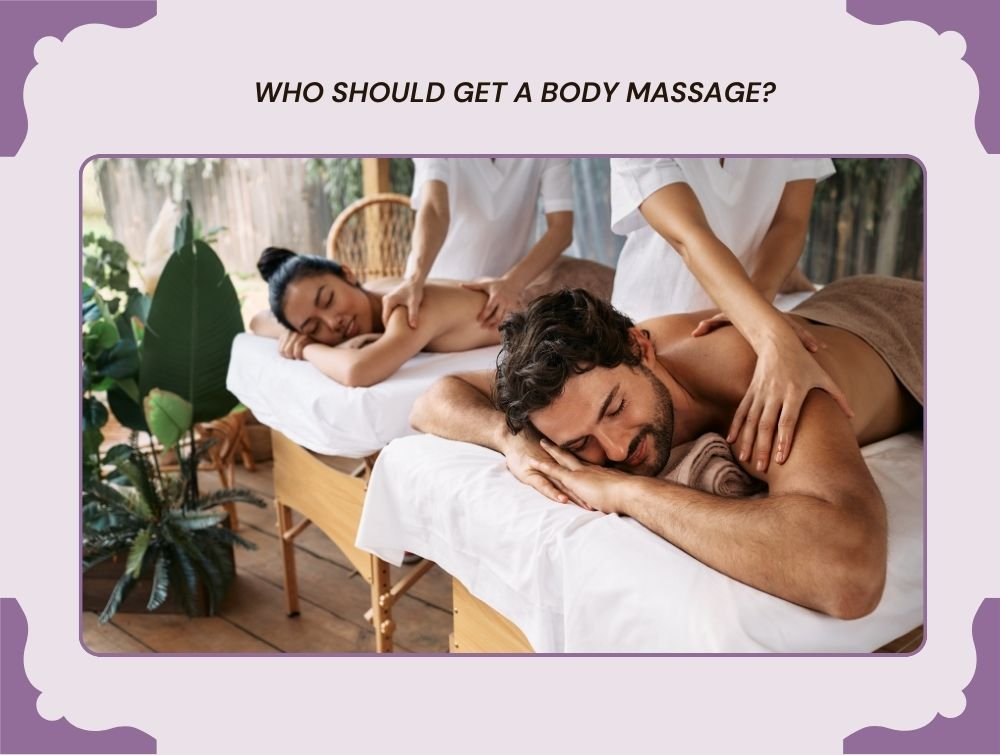
Many people wonder who requires a body massage and whether it’s suitable for everyone. The truth is, body massages can benefit a wide range of individuals, from those dealing with physical stress to those simply looking for relaxation.
Whether you’re managing muscle pain, recovering from an injury, or just need a break from daily routines, massage therapy can offer significant benefits. Let’s explore who can gain the most from regular massages and is body massage safe for everyone.
1. Office Workers Dealing with Stress and Posture Issues
Sitting for long hours at a desk often leads to poor posture, back pain, and stiff shoulders. Office workers are some of the most common recipients of massages, as the therapy helps relieve tension from the neck, shoulders, and lower back. Regular sessions can also improve posture and alleviate stress caused by work pressures.
Why it helps: Relieves muscle stiffness, improves posture, and reduces work-related stress.
2. Athletes and Fitness Enthusiasts with Muscle Tension
Athletes and those who regularly exercise often experience muscle soreness and tightness. Massage therapy can speed up muscle recovery, reduce soreness, and improve flexibility. Techniques like deep tissue massage are particularly effective for targeting deeper muscle layers and enhancing performance.
Why it helps: Promotes muscle recovery, reduces soreness, and boosts flexibility.
3. Individuals Recovering from Injuries or Surgeries
For people healing from injuries or post-surgical procedures, massages can aid in recovery by improving circulation, reducing scar tissue, and restoring mobility. However, it’s essential to consult a healthcare professional before starting any massage therapy post-surgery to ensure safety.
Why it helps: Enhances circulation, speeds up healing, and reduces scar tissue formation.
4. Pregnant Women (With Proper Prenatal Techniques)
Pregnancy can place extra stress on the body, leading to back pain, swollen feet, and general discomfort. Prenatal massages, performed by trained therapists, can help reduce muscle tension, improve circulation, and provide relaxation. It’s essential to ensure the therapist specializes in prenatal techniques to ensure the safety of both mother and baby.
Why it helps: Relieves pregnancy-related aches, reduces swelling, and promotes relaxation.
5. Self-Care Enthusiasts and Housewives Seeking Relaxation
Self-care is essential for mental and emotional well-being, and massages are a perfect way to unwind. Housewives, caregivers, and anyone managing busy routines can benefit from massages that help them relax, reduce stress, and take time for themselves.
Why it helps: Promotes relaxation, reduces daily stress, and enhances emotional well-being.
Is Body Massage Safe for Everyone?
While massages are generally safe for most people, there are certain situations where caution is needed. Individuals with conditions like deep vein thrombosis, severe osteoporosis, or certain skin infections should consult a healthcare provider before scheduling a massage. Pregnant women should also seek therapists trained in prenatal massage to ensure safety.
For the vast majority, however, regular body massages can be a valuable part of a health and wellness routine, offering both physical and emotional benefits.
Safety Tips and Precautions for Body Massage
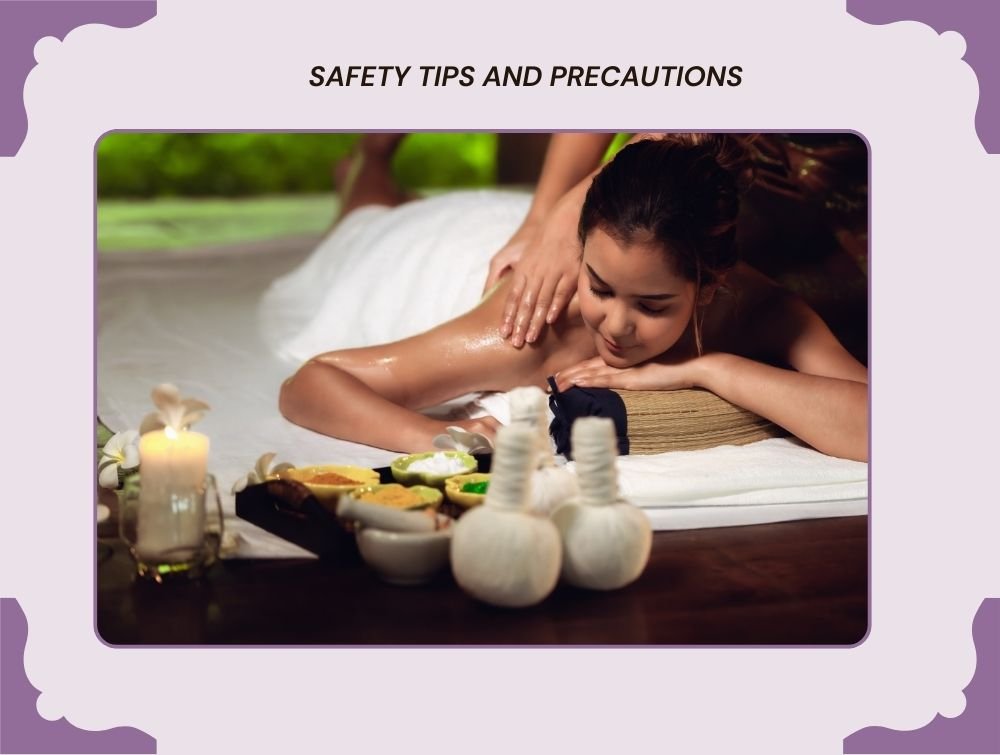
While body massages offer numerous benefits, it’s essential to understand that there are certain safety guidelines to follow to ensure a positive and effective experience. Whether you’re visiting a professional therapist or practicing a massage at home, knowing the right techniques and body massage precautions for beginners can help avoid unnecessary discomfort or injury.
When to Avoid a Body Massage
Although massages are generally safe for most people, there are specific situations where they should be avoided or postponed to prevent complications:
- Recent Injuries: If you’ve recently suffered from a muscle tear, sprain, or broken bone, it’s best to wait until the injury has healed before getting a massage. Massaging a fresh injury can worsen the damage or increase inflammation.
- Blood Clots or Deep Vein Thrombosis (DVT): Individuals with blood clots should avoid massages, especially deep tissue techniques. Applying pressure to an area with a clot can risk dislodging it, leading to severe complications.
- Skin Conditions or Infections: Conditions like rashes, open wounds, or contagious skin infections can worsen with massage. It’s essential to let your skin heal before scheduling a session.
- Fever or Illness: If you’re experiencing a fever or viral illness, it’s best to rest and recover fully before getting a massage. Physical manipulation during illness can strain the body further.
- Pregnancy (Without Prenatal Techniques): While prenatal massages are safe when done by trained therapists, general massage techniques may not be suitable for pregnant women without proper precautions.
Avoiding Common Mistakes During a DIY Massage
If you’re practicing self-massage or giving one to a friend or family member at home, it’s easy to make mistakes that could lead to discomfort. Here are some simple guidelines to avoid them:
- Skipping the Warm-Up: Always start with gentle strokes to warm up the muscles. Jumping directly into deep pressure can cause pain and lead to muscle strain.
- Using the Wrong Oils or Tools: Choosing the right massage oil is essential for a smooth experience. Light oils like sweet almond or coconut work well, while overly sticky or thick oils can cause unnecessary friction.
- Neglecting Feedback: If you’re massaging someone else, regularly check in about pressure and comfort levels. Everyone has a different pain threshold, and communication ensures the massage remains enjoyable.
Using the Right Pressure to Avoid Soreness
One of the most essential aspects of a successful massage is applying the correct amount of pressure. Too little, and the massage won’t be effective. Too much, and it can cause muscle soreness or even bruising.
- Start Light and Build Up: Begin with gentle strokes, gradually increasing pressure as the muscles warm up. This approach helps avoid unnecessary discomfort and allows the body to adjust to deeper techniques.
- Pay Attention to Sensitive Areas: Certain areas, like the lower back, neck, and joints, can be more sensitive to pressure. Be mindful and use lighter strokes on these regions.
- Listen to Your Body: Whether you’re massaging yourself or someone else, tuning into the body’s response is key. Any sharp or shooting pain is a sign to stop or reduce pressure.
By following these body massage precautions for beginners, you can enjoy the benefits of massage therapy safely and effectively. Whether you’re a beginner or experienced, prioritizing safety ensures that every session promotes relaxation and healing without unintended discomfort.
Professional Body Massage Services
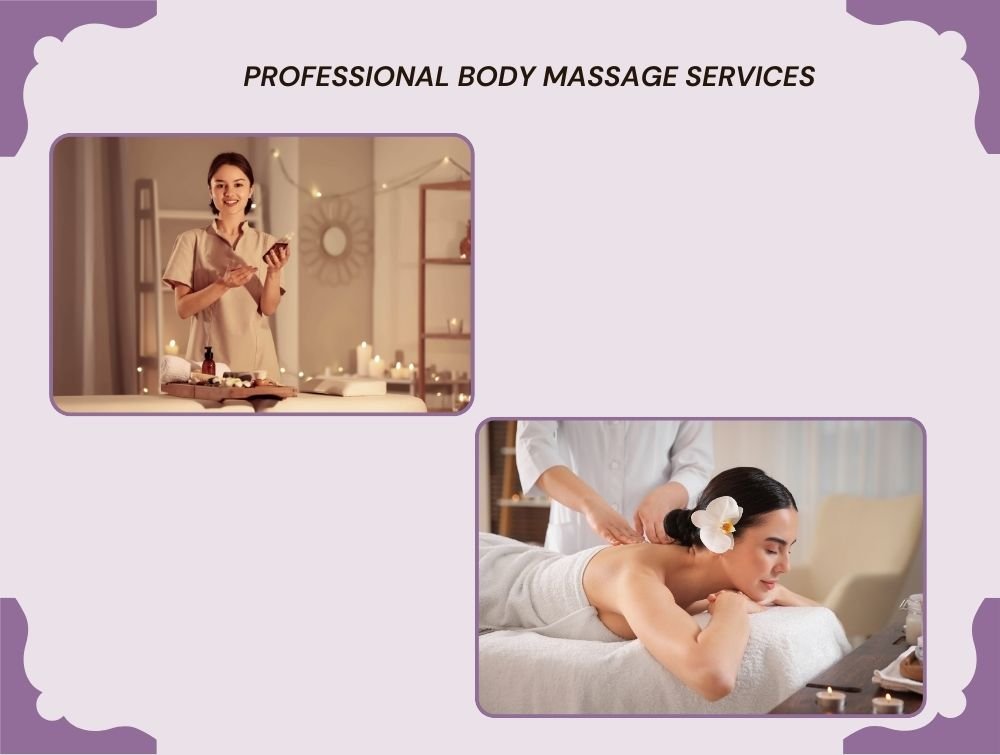
While DIY massages can be helpful for occasional relief, there’s nothing quite like the expertise and precision of a professional massage therapist. Opting for professional body massage services not only ensures the use of proper techniques but also allows for a more relaxing and therapeutic experience tailored to individual needs.
Benefits of Hiring a Professional Massage Therapist
A professional massage therapist brings a level of skill and knowledge that enhances the benefits of massage. Here’s why choosing a professional is often the better option:
- Customized Approach: Therapists assess specific muscle groups and tension points, tailoring each session to focus on your unique needs, whether it’s deep tissue work or gentle relaxation.
- Expertise in Techniques: From Swedish massage to deep tissue massage, professionals are trained in a wide range of techniques, ensuring each stroke and movement is executed safely and effectively.
- Consistent Pressure and Flow: One of the challenges of DIY massages is maintaining consistent pressure and smooth movements. Professionals are skilled at applying the right amount of pressure and seamlessly transitioning between techniques.
- Complete Relaxation: With a therapist handling the work, you can fully relax without worrying about technique or reaching difficult spots. It also eliminates the strain that can come with self-massage.
Fem Spa’s Professional Body Massage Services
At Fem Spa, we understand the importance of a well-executed massage and offer a variety of professional services designed to meet your wellness needs. Our team of trained therapists ensures that every session provides relaxation, relief, and rejuvenation.
- Full Body Massage in Mumbai: Our comprehensive full body massage in Mumbai focuses on overall relaxation and muscle relief. Whether you’re looking to unwind or target specific tension areas, this service covers it all.
- Female to Male Home Massage Service: Experience the ultimate comfort with our female to male home massage service, where our skilled therapists bring the spa experience directly to your home. Perfect for those who prefer privacy and convenience without compromising on quality.
- Spa Service at South Mumbai: Located in a serene setting, our spa service at South Mumbai offers a tranquil environment where you can escape the city’s hustle and focus on self-care. Choose from a range of treatments designed to relax both body and mind.
- Massage Service at Home: For those who prefer the comfort of their own space, our massage service at home provides professional care without the need to travel. Our therapists bring everything needed to create a peaceful, spa-like atmosphere in your home.
DIY Massage vs. Professional Massage: Which Is Better?
While DIY massages can offer quick relief, especially for minor tension or stress, there are limitations to what you can achieve on your own. Here’s how they compare:
- Effectiveness: Professional massages provide deeper and more consistent relief. DIY methods often struggle to match the precision and pressure applied by a trained therapist.
- Safety: Without proper knowledge, DIY massages can sometimes lead to overstretched muscles or excessive pressure in sensitive areas. Professionals know the right techniques to avoid these risks.
- Relaxation: It’s hard to fully relax when you’re focused on performing a massage. A professional allows you to completely unwind while they handle the work.
- Convenience: While DIY is accessible anytime, services like Fem Spa’s massage service at home combine convenience with professional expertise, giving you the best of both worlds.
Choosing professional body massage services offers not only physical relief but also a complete relaxation experience. With options like full body massage in Mumbai and home massage services, Fem Spa ensures that high-quality care is always within reach.
Frequently Asked Questions
If you’re considering getting a body massage or learning how to perform one at home, you likely have some questions. Here are answers to some of the most commonly asked questions to help guide you through the process.
Q1. How long should a full body massage last?
Ans: A typical full body massage lasts between 60 to 90 minutes. This allows enough time to cover all major muscle groups while focusing on specific areas that need extra attention. Shorter sessions, around 30 minutes, can be effective for targeted treatments but might not provide the same overall relaxation.
Q2. What’s the best oil for a relaxing body massage?
Ans: The best oil for a relaxing body massage depends on personal preference and skin type. Popular choices include:
- Sweet Almond Oil: Light and non-greasy, suitable for most skin types.
- Coconut Oil: Offers deep hydration with a pleasant scent.
- Jojoba Oil: Closely mimics the skin’s natural oils, making it ideal for sensitive skin.
- Essential Oils: Adding lavender, eucalyptus, or chamomile essential oils to your base oil can enhance relaxation and offer additional therapeutic benefits.
Q3. Can I perform a body massage without professional training?
Ans: Yes, you can perform a body massage at home without professional training, especially for basic techniques like effleurage and kneading. Following a step-by-step body massage guide at home can help ensure you’re using safe and effective techniques. However, for deeper therapeutic work or to address specific injuries, it’s best to consult a professional.
Q4. Is it safe to give a massage if someone has back pain?
Ans: Massage can be helpful for back pain, but it’s essential to be cautious. If the pain is due to muscle tension or mild strain, gentle techniques like effleurage or petrissage can provide relief. However, if the pain is severe or related to underlying medical conditions like herniated discs, it’s important to seek advice from a healthcare professional before proceeding.
Q5. What’s the difference between deep tissue and Swedish massage?
Ans
- Swedish Massage focuses on relaxation using long, flowing strokes with light to moderate pressure. It aims to improve circulation and ease muscle tension.
- Deep Tissue Massage targets deeper layers of muscles and connective tissue using slower, more intense strokes. It’s designed to address chronic muscle pain and stiffness.
If you’re looking for a soothing experience, Swedish is ideal. For addressing deep-seated muscle tension, a deep tissue massage is more effective.
Q6. How often should I get a body massage for stress relief?
Ans: For regular stress relief, a body massage once every 2 to 4 weeks is often ideal. This frequency helps maintain relaxation, reduces muscle tension, and promotes overall wellness. Individuals experiencing higher stress levels or chronic tension may benefit from more frequent sessions, such as weekly massages.
Q7. Are there any risks associated with DIY massages?
Ans: While DIY massages can be effective for minor tension relief, there are some risks if done improperly:
- Applying excessive pressure can cause muscle soreness or bruising.
- Using incorrect techniques may strain muscles or joints.
- Massaging over areas with inflammation or injury could worsen the condition.
Following body massage precautions for beginners and using proper techniques can help minimize these risks.
Q8. What are the most common mistakes in home massages?
Ans: Some of the most common mistakes in home massages include:
- Skipping warm-up strokes, which can lead to muscle strain.
- Using too much pressure too soon, causing discomfort.
- Ignoring communication it’s essential to check in about pressure and comfort.
- Not using enough oil, which can create friction and skin irritation.
Q9. Can body massage help with injury recovery?
Ans: Yes, body massage can aid in injury recovery by improving circulation, reducing scar tissue, and enhancing flexibility. Techniques like friction and petrissage can help break down adhesions and improve mobility. However, massages should only be performed after consulting with a healthcare professional to ensure it’s appropriate for the specific injury.
Q10. What’s the ideal setting for a home massage?
Ans: The perfect home massage setting should be calm, comfortable, and free from distractions. Consider the following:
- Lighting: Use soft, warm lighting or candles for a soothing atmosphere.
- Music: Play calming music or nature sounds to enhance relaxation.
- Aromatherapy: Use essential oils in a diffuser to create a peaceful ambiance.
- Comfortable Surface: A massage table is ideal, but a firm bed or yoga mat can also work.
Creating a relaxing environment makes the massage more enjoyable and effective.
Conclusion
A body massage offers more than just relaxation it supports muscle recovery, reduces stress, and promotes overall wellness. By understanding the best body massage techniques like effleurage, petrissage, and tapotement, anyone can experience the numerous benefits of body massage right at home.
Whether you’re easing tension from long work hours, helping your body recover post-exercise, or simply taking a moment for self-care, massage therapy provides both physical and mental relief.
Trying a safe at-home massage can be a great way to unwind and reconnect with your body. With a calm setting, the right oils, and some simple techniques, you can create a relaxing experience from the comfort of your home. For those hard-to-reach areas or when deeper muscle relief is needed, incorporating tools like foam rollers or massage balls can make a noticeable difference.
If you’re looking to elevate your relaxation or need professional guidance, Fem Spa offers a range of expert services tailored to your needs. Whether you’re interested in a full body massage in Mumbai, a female to male home massage service, or prefer the ambiance of a spa service at South Mumbai, Fem Spa ensures you receive the highest quality care.
For ultimate convenience, our massage service at home brings relaxation directly to your doorstep, blending professional expertise with the comfort of your own space.
Take a moment today to invest in your well-being. Whether you try an at-home session or schedule an appointment with Fem Spa, the path to relaxation and rejuvenation is just a massage away.

